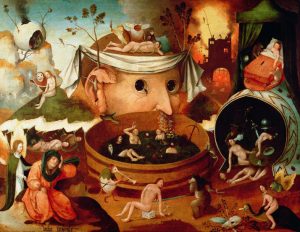
Hieronymus Bosch vs. Lombard Master
Between the end of the 17th and the beginning of the 18th century, an anonymous and eccentric painter worked in Lombardy, known to experts for several decades under the fascinating name of Master of the Fertility of the Egg. An undoubtedly bizarreand in some ways unique artist in Italy whose name is due to the frequent but not exclusive presence of hatching eggs in his paintings and whose canvases are – just like the one we are presenting here – always clearly recognisable and distinguishable for the singular extravagance of the compositions populated by animals, dwarf figures, deformed characters and domestic objects typical of Po Valley culture.

The dominant subject of the Master of the Fertility of the Egg is certainly connected to the ancient thread that links classical painting to dwarf painting. In ancient Egypt, Bes, a dwarf God with crooked legs, a large tongue and a deformed face, was associated with fertility and was believed to propitiate marriages and protect pregnancies. And in Rome too, the fertility of nature was extolled in gardens where Priapus and Pan, dwarfs, nymphs and maenads reigned, so as to became a central theme in painting and sculpture.
A limited number of works are known by the Master of the Fertility of the Egg, most of which have been surveyed and identified in public and private collections, and anyone observing his imaginative compositions cannot help but think that in some way the painter saw or was inspired by those of an illustrious predecessor, the Dutch Hieronymus Bosch.

Bosch is the famous Dutch painter that everyone knows and who lived and worked between the end of the 15th century and the first half of the 16th century – i.e. two centuries before our Lombard Master – whose great value is essentially that he revolutionised the representation of classical Renaissance themes in his time, influencing entire generations of artists from different parts of Europe and from various subsequent ages, starting with a number of Renaissance painters and engravers, up to more modern and contemporary artistic currents such as 19th century Symbolism, early 20th century German Expressionism and Surrealism.

The artistic legacy of Hieronymus Bosch was certainly widespread in northern Europe while his influence on southern European artists is less well known. This is precisely the topic of the current exhibition in Palazzo Reale, in Milan, open until 12 March, investigating the specific influence of Hieronymus Bosch’s art on Italian and Spanish culture, where you have the opportunity to admire some of his masterpieces – from museum institutions such as the Prado and the Museo Lázaro Galdiano in Madrid, the Uffizi Galleries, the Gallerie dell’Accademia in Venice and the Museu Nacional de arte Antiga in Lisbon – compared with paintings and engravings by southern European artists.

Returning to our Lombard painting (Grotesque Scene with Drummer Cat), the extravagant and extremely whimsical spirit of the painting’s almost theatrical representation clearly reveals a painterly will akin to Bosch’s, even if the figurative universe of departure is very different: while the great Dutch artist took inspiration from 14th and 15th century miniatures, drawing extensively on the typical symbols of medieval culture, the Master of the Fertility of the Egg represents in his compositions characters, animals and objects typical of northern Italian culture. Both artists, on the other hand, have a common and meticulous interest in details and satirical depictions of vices that lead them to conceive and paint strong and powerful images, albeit with very often elusive and mysterious meanings
Master of the Fertility of the Egg
(active late 17th – early 18th century)
Grotesque Scene with Drummer Cat
Oil on canvas
Italy, Lombardy
Late 17th century
Cm 91 x 140
© 2013 – 2024 cesatiecesati.com | Please do not reproduce without our expressed written consent
Alessandro Cesati, Via San Giovanni sul Muro, 3 – 20121 Milano – P.IVA: IT06833070151